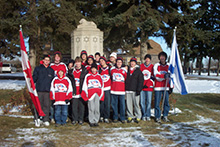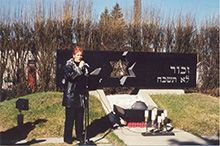Edmonton Chevra Kadisha
By Debby Shoctor
Following the formalization of the Edmonton Jewish Community in 1906 with the establishment of the Edmonton Hebrew Association, Mr. Abraham Cristall, Edmonton’s first Jewish citizen, purchased land on the south side of the North Saskatchewan river on May 26, 1907, for a Jewish Cemetery. The land was located at 7622-101 Ave., which still serves as the community cemetery to this day.
In those days, it was a short distance from the heart of Jewish Community on 95th St. in Edmonton’s East End, down the Dawson hill road, across the road and back up the hill to the cemetery. In the winter, the horse-drawn hearses had to use wooden logs as brakes, but in summer, the going was better. Motorized hearses started in the 1930s.
The first modern organization of a burial society responsible for the entire community was formed in Prague by Rabbi Elezar Ashkenazi in 1564. Its rules and regulations were codified by the Maharal. They became the model for all other Jewish burial societies. The functions of the Burial Society or Chevra Kadisha, literally “Holy Society” arose from two Judaic principles: that reverence must be accorded to the deceased because the body once housed the soul, and secondly, that no profit should be made from the burial of the dead. Therefore the Chevra Kadisha is a charitable society, unlike most non-Jewish burial societies or funeral parlours.
The original Edmonton Men’s Chevra Kadisha members were chosen from the original founders of the Beth Israel Synagogue in 1907. The society was officially incorporated in 1925. The women’s Chevra Kadisha got started unofficially in 1914, but was formalized as a society in 1919 with the adoption of by-laws. The charter members of the organization at that time were: Mrs. H. B. Klein, Tsoril Cristall, Debra Cohen, Zelda Weinberg, Hoda Rodnunsky, and Hinda Baltzan. The men prepare the male members of the community for burial (taharot), and the women prepare the females. The women also stitch the seven burial garments (tachrichim) used to shroud the deceased. Lists of the 92 active Chevra Kadisha members from 1907-1935 can be found on the walls of the Cemetery Chapel.
The tachrichim, or shrouds are fashioned after the garments that the high priest wore in the temple on Yom Kippur. They are white, made of linen, and hand-sewn with no knots so that they will disintegrate easily. They are made without hems, to signify their impermanence, and with no pockets, because you can take no worldly goods with you into the afterlife. Everyone: rich or poor, young or old, are buried in the same garments. The caskets are also uniform, made out of wood, with no nails.
Early on, founding member Jacob Baltzan formed an alliance with local funeral parlour owner J. William Connelly, of Connelly-McKinley funeral directors, to help out with the Jewish funerals by providing the hearse and passenger cars, filing of forms, etc. This relationship has continued until the present day. The cemetery fence and gates were designed and made by Leib Agranov, who formerly worked as Blacksmith to the Czar. He embellished them with beautiful fruits, birds and flowers, which can still be seen today.
At first, there was nothing but a small wooden shed used for shelter out at the cemetery, but from 1930-1935 money was collected to build a permanent chapel there, which was used for services for many years until it became too small to accommodate the growing community. In 1963, the Chesed Shel Emes was built at 12313-105 Ave., a much larger facility, which included rooms for preparing the taharot and for sewing of the tachrichim. The smaller chapel was renovated in the mid-1990s, and is still often used for services.
Other embellishments out at the cemetery later included the erection of a cenotaph after World War II, ca. 1947 with the names of the war dead inscribed onto it, which is used every Remembrance Day. A Holocaust memorial was also erected in the mid-1970s, and was used for Yom Hashoah services every year until the new Holocaust memorial was sculpted by Susan Owen Kagan and placed on the grounds of the Alberta Legislature Building. A guide to the graves was developed and set out in the grounds to help visitors find their loved ones. This guide was revised and updated recently by Cory Felber of JAHSENA, who also photographed every stone in the cemetery for inclusion on the Jewish Online World Burial Registry, which can be accessed at www.jewishgen.org. This allows relatives from all over the world the opportunity to see the headstones of loved ones via the internet.
The headstones are cut to strict standards, and are mostly provided by Edmonton Granite Memorials. An interesting thing about our cemetery is that the graves do not face East, as in most Jewish Cemeteries, but North-South instead. No one seems to know why this is so, it has just always been that way. What is also unique about our cemetery is that it serves all denominations in the community: Orthodox, Conservative and Reform.
The Chevra Kadisha says there is room in the cemetery for community members for about another ten to 25 years, but then they will have to start using land which they bought on 156th St. near St. Albert as an auxiliary location. However, they are still exploring other options. At this time, reservations cannot be made for plots, except for the very elderly or infirm.
Today, the Edmonton Chevra Kadisha is comprised of about 60 volunteers, both men and women, who offer 24-hour service for families of the bereaved. Unlike most North American Chevra Kadishas, the organization is 100 percent volunteer run. The only employee is the caretaker at the Cemetery. Once contacted, the Chevra meets with the family and looks after all funeral arrangements.






